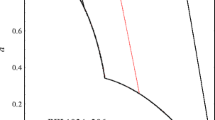Abstract
This paper discusses a statistical method of detecting nonlinearity in the light curves of active galactic nuclei (AGN). We model the light curves of AGN by two-variate stochastic differential equation (SDE) in which one variable is observable but not the other. Applying a nonparametric model of the SDE as well as its parametric models of linear and quadratic functions to the light curves provided by the Kepler satellite, we estimate the three models and thereby compare their prediction accuracy to detect nonlinearity. The results suggest that there exist quadratic or other nonlinearities in the light curves, while the others exhibit linearity.






Similar content being viewed by others
References
O. Adegoke, S. Rakshit, B. Mukhopadhyay, Spectral and time series analyses of the Seyfert 1 AGN: Zw 229.015. Mon. Not. R. Astron. Soc. 466, 3951–3960 (2017)
B.D.O. Anderson, J.B. Moor, Optim. Filter. (Prentice-Hall, New Jersey, 1979)
O. Bleas, General overview of black hole accretion theory. Space Sci. Rev. 183, 21–41 (2014)
N. Caplar, S.J. Lilly, B. Trakhtenbrot, Optical variability of AGNs in the PTF/iPTF survey. Astrophys. J. 834, 111 (2017)
R. Edelson, S. Vaughan, M. Malkan, B.C. Kelly, K.L. Smith, P.T. Boyd, R. Mushotzky, Discovery of a \(\sim 5\) day characteristic timescale in the Kepler power spectrum of Zw 229–15. Astrophys. J. 795, 1 (2014)
A.H. Jazwinski, Stochastic Processes and Filtering Theory (Academic Press, New York, 1970)
V.P. Kasliwal, M.S. Vogeley, G.T. Richards, Are the variability properties of the Kepler AGN light curves consistent with a damped random walk? Mon. Not. Roy. Astron. Soc. 451, 4328–4345 (2015)
V.P. Kasliwal, M.S. Vogeley, G.T. Richards, Extracting information from AGN variability. Mon. Not. R. Astron. Soc. 470, 3027–3048 (2017)
B.C. Kelly, A.C. Becker, M. Sobolewska, A. Siemiginowska, P. Uttley, Flexible and scalable methods for quantifying stochastic variability in the era of massive time-domain astronomical data sets. Astrophys J 788, 1 (2014)
A. Lawrence, Classification of active galaxies and the prospect of a unified phenomenology. Publ. Astron. Soc. Pac. 99, 309–334 (1987)
R. Maiolino, G.H. Rieke, Low-luminosity and obscured Seyfert nuclei in nearby galaxies. Astrophys. J. 454, 95–105 (1995)
R.F. Mushotzky, R. Edelson, W. Baumgartner, P. Gandhi, Kepler observations of rapid optical variability in active galactic nuclei. Astrophys. J. Lett. 743, L12 (2011)
H. Netzer, Revisiting the unified model of active galactic nuclei. Annu. Rev. Astron. Astrophys. 53, 365–408 (2015)
T. Ozaki, Time Series Modeling of Neuroscience Data (CRC Press, Boca Raton, 2012)
M. Revalski, D. Nowak, P.J. Wiita, A.E. Wehrle, S.C. Unwin, Investigating the variability of active galactic nuclei using combined multi-quarter Kepler data. Astrophys. J. 785, 60 (2014)
C.K. Seyfert, Nuclear emission in spiral nebulae. Astrophys. J. 97, 28–40 (1943)
I. Shoji, A comparative study of maximum likelihood estimators for nonlinear dynamical system models. Int. J. Control 71, 391–404 (1998)
I. Shoji, A nonparametric method of estimating nonlinear dynamical system models. Phys. Lett. A 277, 159–168 (2000)
I. Shoji, Nonparametric filtering for stochastic nonlinear oscillations. Phys. Rev. E 102, 052221–12 (2020)
I. Shoji, T. Ozaki, A statistical method of estimation and simulation for systems of stochastic differential equations. Biometrika 85, 240–243 (1998)
I. Shoji, T. Takata, Y. Mizumoto, A geometric method of analysis for the light curves of active galactic nuclei. Mon. Not. R. Astron. Soc. 495, 338–349 (2020)
T. Simm, M. Salvato, R. Saglia, G. Ponti, G. Lanzuisi, B. Trakhtenbrot, K. Nandra, R. Bender, Pan-STARRS1 variability of XMM-COSMOS AGN II. Physical correlations and power spectrum analysis. Astron. Astrophys. 585, A129 (2016)
C.M. Urry, P. Padovani, Unified schemes for radio-loud active galactic nuclei. Publ. Astron. Soc. Pac. 107, 803–845 (1995)
A.E. Wehrle, P.J. Wiita, S. C. et al., Kepler photometry of four radio-loud active galactic nuclei in 2010–2012. Astrophys. J. 773, 89 (2013)
Acknowledgements
We thank anonymous referees for their helpful comments and suggestions.
Author information
Authors and Affiliations
Corresponding author
Appendix
Appendix
This appendix presents an outline of derivation for NPF. More detail discussion can be seen in Shoji [18, 19].
First suppose the truncated Taylor’s expansion of f around \({{\varvec{x}}}_0=(x_0,y_0)\) up to second order for simplicity although higher order expansion is possible. Then, we get
Let \(X_t=(X_{1,t},X_{2,t}){^T}\) and define \(Y_t={\tilde{f}}(X_t)\) by putting \(X_s\) into \({{\varvec{x}}}_0\) where \(s\le t\). Because \({\tilde{f}}\) is at most quadratic, repeated application of the Ito’s formula gives
where
To discretize the process at discrete times \(\{t_k\}_{1\le k\le n}\), we assume that each integrand is a constant over the time interval \([t_k,t_{k+1})\). However, because we assume no function form of f, we must estimate \(Y_t^{(i,j)}\) from discrete observation \(\{Z_{t_k}\}_{1\le k\le n}\). To this end, we replace \(Y_{t_k}^{(i,j)}\) with its filter value, or \( Y_{t_k|t_k}^{(i,j)}=E[Y_{t_k}^{(i,j)}|\{Z_{t_j}\}_{1\le j\le k}]\). This replacement is also used for the formulation of the extended Kalman filter algorithm; see Anderson and Moor [2] and Jazwinski [6]. Furthermore, the last 3 equations imply that \(Y_{t_k}^{(i,j)}(i+j=2)\) are constant. Denoting them by \(\theta _j\) \((0\le j\le 2)\), we estimate \(\theta _j\) as nuisance parameters from the data. Under the above setting, the following equations in discrete time are obtained:
By substituting \(f(X_{t})\) for \({\tilde{f}}(X_{t})=Y_{t}^{(0,0)}\) together with,
we get a linear approximate SDE of (1)–(2). Since a linear SDE has an exact form of the solution, the approximate discretization at \(t=t_{k+1}\) is given by
where
See [14] and Shoji and Ozaki [17] for details. Using this and the equations of \(Y^{(i,j)}_{t_{k+1}}-Y^{(i,j)}_{t_{k}}\) above, we obtain the formula for NPF.
Rights and permissions
About this article
Cite this article
Shoji, I., Takata, T. & Mizumoto, Y. Detecting nonlinearity in the light curves of active galactic nuclei. Eur. Phys. J. Plus 136, 105 (2021). https://doi.org/10.1140/epjp/s13360-021-01105-8
Received:
Accepted:
Published:
DOI: https://doi.org/10.1140/epjp/s13360-021-01105-8




